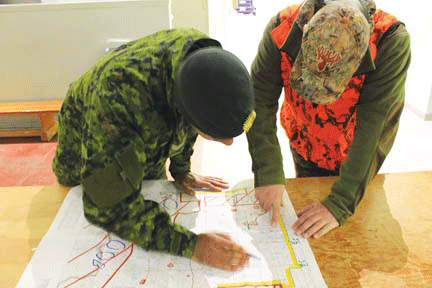Current Temperature
23.4°C
Elk hunt set to go ahead Jan. 11 at CFB Suffield
Posted on January 5, 2016 by 40 Mile Commentator PHOTO COURTESY OF CFB SUFFIELD - Cpl. tyler Kennedy, a Canadian Armed Forces reservist brought in to support the Elk Herd Reduction program at CFB Suffield, explains the map of the training area to local hunter, Joel Nicholson.
PHOTO COURTESY OF CFB SUFFIELD - Cpl. tyler Kennedy, a Canadian Armed Forces reservist brought in to support the Elk Herd Reduction program at CFB Suffield, explains the map of the training area to local hunter, Joel Nicholson.By Natalie Finnemore
Public Relations Officer, CFB Suffield
On the streets of the Canadian Forces Base (CFB) Suffield community you’ll notice even more people dressed in camo than usual, and not the usual army camouflage either.
Hunters are donning their brightest blaze orange and cloaking themselves in hunting camo as they journey to the base from throughout Alberta and Saskatchewan to take part in the Alberta Environment and Park’s (AEP) Elk Herd Reduction Program (EHRP).
Thousands of people will be gathering at the largest training area in the country to take part in the fourth annual EHRP, also known as the elk hunt, which continues into its final weeks from Jan. 11-30, 2016.
Few topics ignite more passionate debate in southern Alberta than hunting and its environmental impacts.
“One of the more important aspects of the hunt is the dialogue we have with the larger community, including the farmers and residents surrounding the base,” said Lt. Col. John Scott, Base Commander at CFB Suffield. “It’s important to us to be actively listening to their concerns and responding to any challenges that may arise.”
Lead by the Province of Alberta, CFB Suffield is facilitating the event co-ordination and safety aspects of the hunt.
The hunt at CFB Suffield is by far the largest in the region, and each person who attends the elk hunt spends about $1,500 in the local economy, according to provincial estimates. The EHRP at CFB Suffield stimulates the local economy and brings tourism to the region. On an average week during the 2015 season, CFB Suffield welcomes up to 1,000 hunters and their helpers to participate in the EHRP.
“The base stabilizes the local economy, even during the current times of economic downturn,” said Scott. “Important initiatives, such as the elk hunt, bring the community together as we welcome visitors from throughout our region into our training area and in Medicine Hat. What’s important for people to take away from the EHRP is that this is success story for the base and the local community,” said Scott. “Although the reduction strategy is a relatively new program, we hope to play a leadership role in creating positive change for all inhabitants, including people, animals and plant species that co-exist on the training area.”
The goal of the EHRP is to reduce the population of elk herd to a sustainable level for the area with targets set by the province. Currently, about 6000 elk graze within the area in and around the base, according to AEP.
Bringing the population down to a more manageable level for the area reduces the strain on the ecosystem, preserves crops in neighbouring farm fields and increases safety on nearby highways.
“Grazing is an important disturbance that shapes the evolution of North American grasslands which drives important ecological processes, and the reintroduction of elk has restored some environmental stability across the base,” said Drew Taylor, Range Biologist, CFB Suffield.
There is a delicate balance to be achieved in managing the elk population. They benefit the base by grazing which helps the prairie ecosystem.
“Although cattle fulfill the role of a large grazer in most of the Canadian prairies, cattle fences and manoeuvering tanks are incompatible. Grass is not a large component of other prairie animals’ diets, such as deer and antelope,” Taylor said. “However, without a natural predator to regulate the elk population at Suffield, human intervention is needed to maintain ecologically sustainable numbers.”
Leave a Reply
You must be logged in to post a comment.

